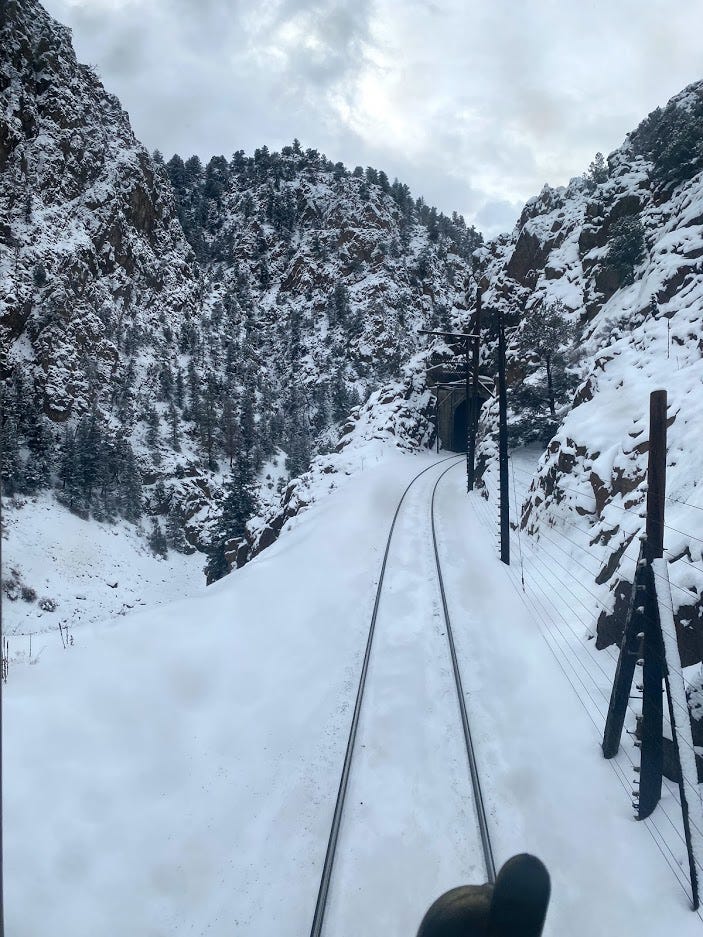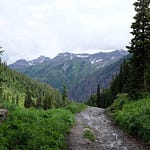Good evening.
1.
When I was 12, I got a job as student reporter for my school paper. To file my first report, one of my cousins, a civil engineer, took me to her work so I could observe engineers install a new railroad track that would pass not far from the school. On that sunny summer day in the back canyons of north San Diego County, I was mesmerized.
The first step in laying down a track isn’t obvious. It happens below the surface. Like drainage systems on a farm, the ground is first graded then pipes laid in to ensure water never logs below the grade that could cause erosion or degradation. Next, a layer of coarse sand creates a slightly malleable but firm ballast to which crossties can be secured. Crossties can be of timber or concrete, and it’s important to align the center of the ties to the center of the tracks. If not, the ties will tilt.
Now the rails are lowered and bolted onto the ties. More calibrations happen at this stage to ensure a precise alignment. It used to be that the rails were joined with fishplates, metal bars with tapered ends. Now it’s common to weld the rails, as technology improves to ensure ambient temperature fluctuations don’t expand or contract the rail.
At this point another layer of ballast is applied, consisting of small, irregular rocks. Under gravity, they bunch up and tighten the hold of the track system as a whole. After some trains pass, a third layer of ballast can be applied as the weight and vibration of the trains shake up the rocks, helping them find odd, loose spaces to fill and making the base even stronger.
While on break, one of the engineers asked me if I knew how wide the rails were spaced apart. I did not. Four feet and eight-and-a-half inches exactly. And how was this distance, also know as the standard gauge, determined?
More popular than fact was a debunked myth that Colonial America engineers selected the gauge in honor of the Imperial Roman chariot, which just about accommodated two horses cantering forth side-by-side. While the measurements do roughly match, historical records show it was less the result of a singular, conscious, and affirmative decision than coincidences of history and a self-reinforcing socioeconomic phenomenon called path dependence.
2.
At the heart of physics is the study of a system’s behavior in terms of its motion as a function of time. Expressed in equations of motion, behaviors can be modeled mathematically, which could then be used for predictions.
One such behavior is called holonomy. In a holonomic system, as long as we know the position of an object, we know its state. It doesn’t matter what path or how long the object takes to get to that position.
A nonholonomic system, by logic, is then any system where the state of an object depends on the path it takes to get to its position. An example of a nonholonomic system is a model globe on a desk. Imagine the globe at rest and on the surface of the globe currently in contact with the desk is the country of Malaysia. Now roll the globe along any continuous path on the desk but return it to its original location without slipping, twisting, or picking it up. It’s unlikely the part touching the original spot on the desk is still Malaysia. The state of the globe depends on the path it takes.
Path dependence, when extended into social sciences, partially explains why the standard gauge in the United States today approximates that of the Imperial Roman chariot. As painstakingly documented by economist Douglas Puffert in his book Tracks Across Continents, Paths Through History, the standard gauge was an early beneficiary of what we today call the network effect. When early vehicles were designed, tools were created to make and repair them. The more these tools were adopted, the more it made sense to keep making vehicles according to specifications these tools were designed to work with, even as new vehicle technologies emerged.
But powerful they may be, network effects aren’t sufficient to explain entirely the survival of the gauge. Coincidences of history also played a role. Before the start of the American Civil War, for example, there were nine regional rail networks and each had to determine which gauge to adopt. Professor Puffert notes:
[T]he process was path dependent, in that later outcomes depended on the specific course of preceding events rather than simply on such a priori factors as technology, tastes, or factor endowments.
Further, engineers didn’t base their decision on the most widely used gauge in the nation as a whole, but whatever was adjacent to their region. This was borne out by data showing that, despite the supposedly standard gauge of four feet and eight-and-a-half inches representing 80% of all rails in the 1830s, it dropped to merely 55% by the 1860s.
What reversed the decline was historical coincidence: Northern generals and military planners happened to recognize and take advantage of the superior logistics of railroads before their Southern counterparts. In the Atlanta campaign, for example, Major General William T. Sherman used rail to not only increase speed but also scale. According to military historian Christopher Gabel in his book Railroad Generalship: Foundations Of Civil War Strategy:
In previous North American wars, armies of 30,000 taxed the limits of wagon-haul logistics and local requisition. But in 1864, Sherman waged an offensive campaign with an army of 100,000 men and 35,000 animals. His supply line consisted of a single-track railroad extending 473 miles from Atlanta to his main supply base at Louisville. Sherman estimated that this rail line did the work of 36,800 wagons and 220,800 mules!
It shouldn’t be surprising that after the Union had won the war, the gauge used by the Union became the national standard, and that gauge was: four feet and eight-and-a-half inches.
In other words, history matters. Had the Union lost the war, it’s far from clear what our railroad gauge would be today.
3.
While path dependence is an excellent descriptive framework to analyze nature and socioeconomic events, its utility as a normative framework for the entrepreneur is even greater. On the one hand, the network effect element of path dependence feeds much of the business literature today, as social media networks and gig economy marketplaces exploit the self-reinforcing forces of two-sided demand and supply.
On the other hand, path dependence could also lull established players into complacency. With success, entrepreneurs begin to look for formulae to replicate. Instructive rules are articulated on analyst calls and in employee handbooks. Investors, pundits, and publishers propagate a sense of infallibility. Soon, board strategy meetings center around a schematic of the company’s flywheel. Investments are weighed based on their ability to take advantage of or strengthen the flywheel.
I want to be clear. Learning from past actions and elevating the quality of thinking are absolutely critical to long-term entrepreneurial success. It’s that often the conventional tools of strategic analysis implicitly assume a static landscape in which past success can be replicated with the same actions that led to it. But as the late Professor Clayton Christensen of Harvard Business School explains in the innovator’s dilemma, established players fail not because they lose their edge in what they do well but because what they do well becomes less relevant in the face of a disruptor. Path dependence is fundamentally a mindset of conservatism, solving for the optimal equilibrium between innovation risk and short-term profit. Guide investments by the flywheel by all means, but the greater long-term threat to the entrepreneur isn’t investing outside the flywheel but that someone else develops a different flywheel with better product-market fit.
As to commentators and analysts, the frame of path dependence offers a lesson for our craft as well. In 1927, Austrian journalist and biographer Stefan Zweig published a celebrated book, Sternstunden der Menschheit (Stellar Moments in Mankind), in which individual historical characters were given significant credit for particular courses of history. As is with pundits in general, Zweig excelled at gathering information, striking up useful friendships, and reconstructing a scene of significance. But in searching for a moment that was not only significant but also dramatic to retell, analysts fall victim to exaggerating its significance. And as Sternstunden der Menschheit gained widespread readership not only in Continental Europe but also the United States and Latin America, it became a mold plate of sorts for many subsequent historical analyses based on biographies.
Ironically, Zweig gives a half-warning against this approach in his book:
When it looks at great accomplishments, the world, bent on simplifying its images, likes best to look at the dramatic, picturesque moments experienced by its heroes.... But the no less creative years of preparation remain in the shadow.
In physics, a system may be falsely identified as nonholonomic if adding a parameter, also known as raising the dimension of the space, allows the system to satisfy holonomic constraints. Using the model globe example, if the globe must return to its original position on the desk by precisely retracing its path, then the country of Malaysia would once again make contact with the desk when the globe returns.
The last year has upended and subverted not only the lives of too many of us, but our beliefs. Our world may or may not be a nonholonomic system at a higher dimension, but we are unlikely to return to the world that was. Perhaps the lesson here then is to beware of both the power and the constraints of path dependence, and in building a more resilient future for ourselves and others, we look for ways to free ourselves of the burden of our success, even as we build upon it.
If you’ve enjoyed this update, please consider forwarding to a friend or subscribing below. Thank you for your support.
From Aspen, Colorado
Victor














Share this post